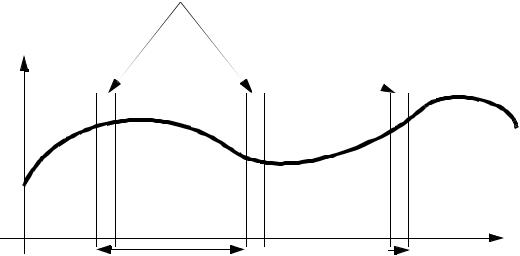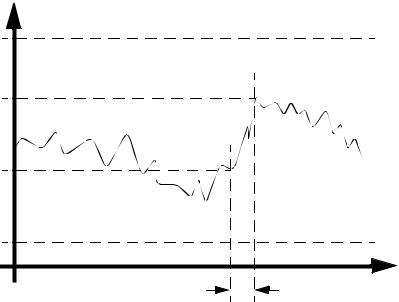
- •1. TABLE OF CONTENTS
- •2. COMPUTER HARDWARE
- •3. A BRIEF OVERVIEW OF COMPUTER HARDWARE
- •3.1 BASIC COMPONENTS
- •3.1.1 The components of a computer are,
- •3.1.2 Some I/O Devices
- •3.2 AN EXAMPLE OF A COMPUTER IN MANUFACTURING
- •3.3 COMMERCIAL COMPUTERS
- •3.3.1 Mainframes
- •3.3.2 Super Computers
- •3.3.3 Workstations
- •3.3.4 Personal Computers
- •3.3.5 Dedicated Computers
- •3.3.6 Single Board Computers
- •3.4 ARCHITECTURE AND BUSES
- •3.4.1 Clock Speed and the Buses
- •3.5 SOFTWARE
- •4. COMPUTER INTERFACING
- •4.1 DIGITAL SIGNALS
- •4.2 ANALOG SIGNALS
- •4.2.1 Analog to Digital Conversion
- •4.2.1.1 - Flash A/D Converter
- •4.2.2 Digital to Analog Conversion
- •4.3 TIMING
- •4.3.1 Interrupts
- •4.3.2 Clocks and Timers
- •4.3.3 Watch Dog Timers
- •4.3.4 Polling
- •4.4 DISPLAYS
- •5. COMPUTER INTERFACE BOARDS
- •5.1 OVERVIEW
- •5.1.1 Types
- •5.2 REGISTER LEVEL PROGRAMMING
- •5.3 EXAMPLES
- •6. COMPUTER CONTROL OF PROCESSES
- •6.1 TEMPERTURE CONTROL
- •6.2 BATCH PROCESSING
- •6.3 COMPUTER PROCESS MONITORING
- •6.4 IMPLEMENTING A COMPUTER CONTROL SYSTEM
- •6.4.1 SCADA
- •6.5 PRACTICE PROBLEMS
- •7. COMPUTER COMMUNICATIONS
- •7.1 COMPUTER COMMUNICATIONS CATEGORIES
- •7.2 THE HISTORY
- •7.3 SERIAL COMMUNICATIONS
- •7.6 GPIB/IEEE-488
- •7.7 PARALLEL COMMUNICATIONS
- •8. INTERFACING COMPUTERS FOR DATA TRANSFER
- •8.1 SERIAL DATA TRANSFER
- •8.2 PARALLEL DATA TRANSFER
- •8.2.1 GPIB Bus (IEEE-488)
- •9. COMPUTER NETWORKING
- •9.1 OSI NETWORK MODEL
- •9.1.1 Why Use A Network?
- •9.1.1.1 - Physical Layer
- •9.1.1.2 - Data Link Layer
- •9.1.1.3 - Network Layer
- •9.1.1.4 - Transport Layer
- •9.1.1.5 - Session Layer
- •9.1.1.6 - Presentation Layer
- •9.1.1.7 - Application Layer
- •9.2 OPEN SYSTEMS
- •9.3 NETWORKING HARDWARE
- •10. MANUFACTURING AUTOMATION PROTOCOL (MAP)
- •10.1 OVERVIEW
- •10.2 DETAILS
- •10.2.1 Physical Alternatives (Layer 1 OSI Model),
- •10.2.2 Data Link Layer (Layer 2 OSI Model),
- •10.2.3 Application Layer:
- •10.3 DETAILS FOR TOP
- •10.3.1 Application Layer:
- •10.5 MAP AND OTHER STANDARDS
- •10.6 AN EXAMPLE OF A MAP IMPLEMENTATION
- •10.7 ETHERNET
- •10.7.1 Internet
- •10.7.2 SLIP/PPP
- •10.8 DATA HIGHWAY+
- •10.9 REMOTE PLC I/O
- •10.10 DEVICENET
- •10.11 OTHER STUFF
- •10.12 Network Facts
- •11. DATABASE TECHNOLOGY
- •11.1 DISTRIBUTED DATABASE SYSTEMS
- •11.1.1 Relational database systems
- •11.1.2 Issues for distributed database systems
- •11.1.2.1 - Query processing
- •11.1.2.2 - Concurrency control

page 16
Voltage is sampled during these time periods
voltage |
time |
(Sampling Frequency)-1 |
Sampling time |
4.2.1 Analog to Digital Conversion
•When there are analog values outside a computer, and we plan to read these to digital values, there are a variety of factors to consider,
-when the sample is requested, a short period of time passes before the final sample value is obtained.
-the sample value is ‘frozen’ after a sample interval.
-after the sample is taken, the system may change
-sample values can be very sensitive to noise
-the continuous values of the signal loose some accuracy when conversion to a digital number
•Consider the conversion process pictured below,

page 17
V( t) |
|
|
Vmax |
V2 |
|
V1 |
|
|
Vmin |
|
t |
|
τ |
t1 |
t2 |
where, |
|
V( t) |
= |
the actual voltage over time |
|
τ |
= |
sample interval for A/D converter |
|
t |
= time |
||
t1, t2 |
= |
time at start,end of sample |
|
V1, V2 |
= voltage at start, end of sample |
||
Vmin, Vmax = input voltage range of A/D converter
N= number of bits in the A/D converter
•Once this signal is processes through a typical A/D converter we get the following relations (these may vary slightly for different types of A/D converters).
page 18
R = 2N
|
|
|
V2 |
– Vmin |
|
|
|
|
|||
VD = INT |
|
|
R – 0.5 |
|
|||||||
|
---------------------------- |
|
|||||||||
|
|
|
V |
|
|
– V |
|
|
|
|
|
|
|
|
|
max |
|
min |
|
|
|
||
|
|
|
|
|
|
|
|
||||
VERROR = |
|
Vmax |
– Vmin |
|
|
|
|||||
---------------------------- |
|
|
|
||||||||
|
|
|
|
2R |
|
|
|
|
|
||
where, |
|
|
|
|
|
|
|
|
|
|
|
R = |
resolution of A/D converter |
||||||||||
VD = |
|
the integer value of the voltage |
|||||||||
VERROR = |
the maximum quantization error |
||||||||||
•In most applications a sample is taken at regular intervals, with a period of ‘T’ seconds.
•In practice the sample interval is kept as small as possible. (i.e., tau << T)
•If we are sampling a periodic signal that changes near or faster that the sampling rate, there is a chance that we will get a signal that appears chaotic, or seems to be a lower frequency. This phenomenon is known as aliasing.
•Quite often an A/D converter will multiplex between various inputs. As it switches the voltage will be sampled by a ‘sample and hold circuit’. This will then be converted to a digital value. The sample and hold circuits can be used before the multiplexer to collect data values at the same instant in time.
4.2.1.1 - Flash A/D Converter
• On type of A/D converter is the flash converter shown below,
